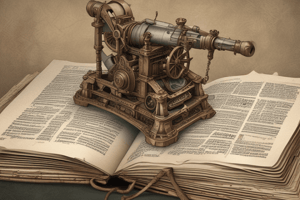Podcast
Questions and Answers
What was the primary material used for writing in Europe before the popularity of paper, according to Julia Dreyfuss in the TedEd video?
What was the primary material used for writing in Europe before the popularity of paper, according to Julia Dreyfuss in the TedEd video?
- wooden tables
- metal plates
- animal hides (correct)
- papyrus
What influenced the creation of countless typesetting styles, according to Julia Dreyfuss in the TedEd video?
What influenced the creation of countless typesetting styles, according to Julia Dreyfuss in the TedEd video?
- ink made from plant materials and water
- Chinese calligraphy
- use of straps for book binding
- Roman type developed by Nicholas Jenson (correct)
What was used to keep books together before the end of the 15th century, according to Julia Dreyfuss in the TedEd video?
What was used to keep books together before the end of the 15th century, according to Julia Dreyfuss in the TedEd video?
- papyrus scrolls
- leather covers
- metal plates
- wood (correct)
What was the turning point in book history, according to Julia Dreyfuss in the TedEd video?
What was the turning point in book history, according to Julia Dreyfuss in the TedEd video?
How was ink made for writing before metal plates were used, according to Julia Dreyfuss in the TedEd video?
How was ink made for writing before metal plates were used, according to Julia Dreyfuss in the TedEd video?
Paper was first invented in China more than 200 years after Europeans began using it extensively, according to Julia Dreyfuss in the TedEd video.
Paper was first invented in China more than 200 years after Europeans began using it extensively, according to Julia Dreyfuss in the TedEd video.
The use of straps became popular for producing durable books towards the end of the 17th century, and it remained the primary method for book binding, according to Julia Dreyfuss in the TedEd video.
The use of straps became popular for producing durable books towards the end of the 17th century, and it remained the primary method for book binding, according to Julia Dreyfuss in the TedEd video.
Flashcards are hidden until you start studying
Study Notes
- Hani Eldalees raises questions about what makes a book, something that stores and conveys information, or just a collection of papers, covers, and binding?
- Books were originally made up of bound sheets of paper.
- The turning point in book history was the invention of movable-type printing by Johannes Gutenberg in the mid-15th century.
- Before Gutenberg's invention, the upper classes had the power to control the production of texts.
- With the ease of printing and mass production, books began to spread throughout Europe.
- Paper was first invented in China more than 200 years before Europeans began using it extensively.
- Europeans initially wrote on wooden tables or animal hides before the popularity of paper spread.
- Ink was made by combining plant materials and water, but metal plates needed to be used instead when water didn't adhere to metal letters.
- The first printed books used reverse letters on lead plates made by hand, which were expensive and had varying quality.
- The mass production capabilities enabled the application of standardized sizes and the development of text processing systems.
- The typesetting style, such as the Roman type developed by Nicholas Jenson, has influenced the creation of countless others.
- Before the end of the 15th century, materials like wood or bound papers were used to keep books together.
- The use of straps became popular for producing durable books towards the end of the 17th century, but it was later replaced by a cheaper alternative.
- Early books were often plain, with no decorative elements, making them easier to read by separating books on the table.
- Covers were initially simple, but their importance grew, and decorative covers became a marketing tool as early as the historical book's inception.
- The shift from physical books to screens and electronic files raises questions about whether these digital files can be considered true books.
- The sensory experience of feeling the cover or the smell of the paper may add to the overall reading experience.
- Magic lies in the words themselves, but the method of reading can also change the experience.
Studying That Suits You
Use AI to generate personalized quizzes and flashcards to suit your learning preferences.





